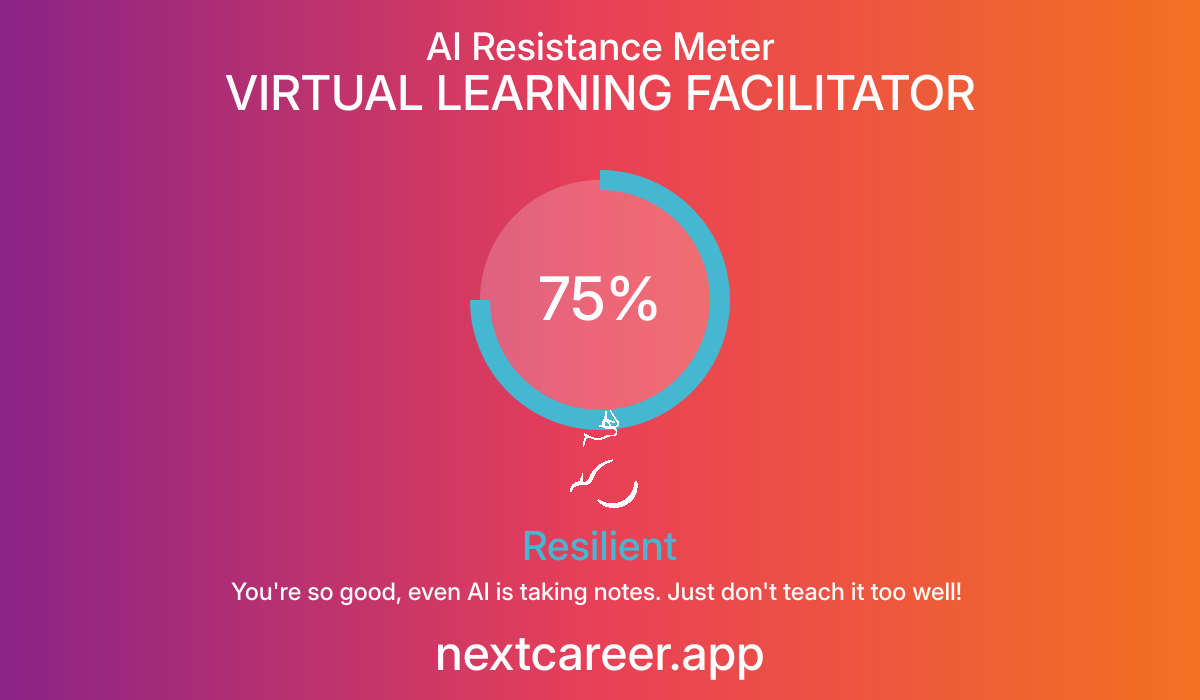AI Resistance Analysis
VIRTUAL LEARNING FACILITATOR
VIRTUAL LEARNING FACILITATOR
AI Resistance Score
AI Resistance Meter
Resilient
VIRTUAL LEARNING FACILITATOR
You're so good, even AI is taking notes. Just don't teach it too well!
The role of a Virtual Learning Facilitator involves guiding and supporting learners in a digital environment, requiring a combination of cognitive skills, emotional intelligence, and adaptability to meet the needs of diverse learners. Given the advancements in AI technologies for content delivery and assessment, the role is partially vulnerable; however, the human element inherent in teaching and mentoring remains a strong advantage, especially as individual learning preferences become a critical focus. The role is likely to evolve to encompass more personalized learning experiences and human-AI collaboration, which can enhance educational outcomes rather than undermine the facilitator's position.
The role of a Virtual Learning Facilitator involves guiding and supporting learners in a digital environment, requiring a combination of cognitive skills, emotional intelligence, and adaptability to meet the needs of diverse learners. Given the advancements in AI technologies for content delivery and assessment, the role is partially vulnerable; however, the human element inherent in teaching and mentoring remains a strong advantage, especially as individual learning preferences become a critical focus. The role is likely to evolve to encompass more personalized learning experiences and human-AI collaboration, which can enhance educational outcomes rather than undermine the facilitator's position.
Key Factors
- Cognitive Tasks: AI can assist in creating personalized learning paths and analyzing learner performance, potentially handling some facets of the learning facilitation process.
- Emotional Intelligence: The need for empathy, motivation, and interpersonal skills in facilitating learning experiences remains a key strength for human facilitators.
- Physical Skills: The role is primarily virtual, limiting the impact of physical skills on AI resistance.
- Creative Thinking: The ability to creatively adapt teaching methods and materials to engage learners is a distinctly human capability that fosters innovation in learning.
Human Advantages
- Emotional support and motivation for learners, fostering engagement and persistence.
- Flexibility in adapting teaching methods based on real-time feedback from learners.
AI Vulnerabilities
- AI can offer personalized learning experiences and automation in grading and feedback.
- Some standard facilitation tasks can be automated, reducing the need for human facilitators.
Recommended Actions
- Invest in professional development focused on emotional intelligence and adaptive teaching strategies.
- Leverage AI tools for data analytics to enhance understanding of learner needs and outcomes.
- Cultivate a community of practice among facilitators to share best practices related to human-AI collaboration.
In the near term (5 years), AI tools will augment the role of Virtual Learning Facilitators by handling routine tasks and providing data-driven insights. Facilitators will increasingly focus on interpersonal engagement, mentorship, and personalized support. In the long term (20+ years), we may see a hybrid model where AI assumes more mundane aspects of facilitation, allowing human facilitators to enhance the emotional and motivational components of learning. The role will likely evolve into more of a coach or mentor position rather than traditional instruction, emphasizing skills such as adaptability, empathy, and individualized support.

Why Calculate AI Resistance?
Understanding how AI-resistant your career is becoming increasingly important in today's rapidly evolving job market. Our analysis combines multiple factors including required human skills, technological adaptability, and future industry projections to give you a comprehensive view of your career's sustainability.